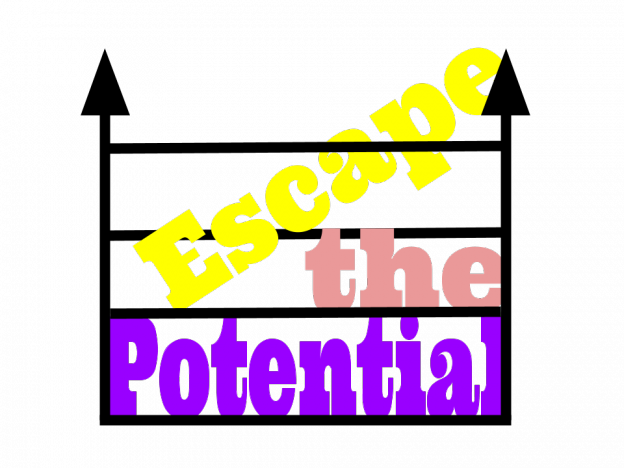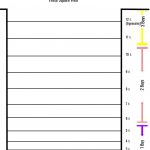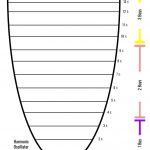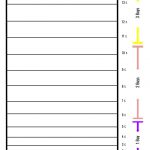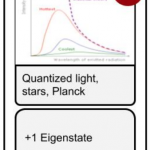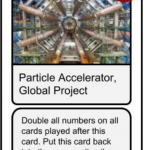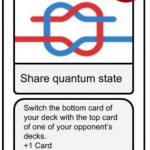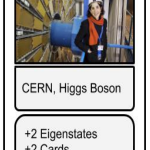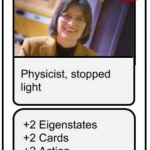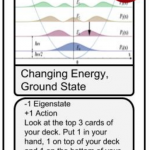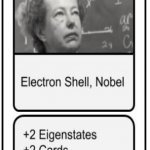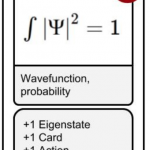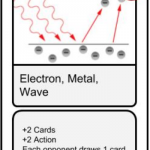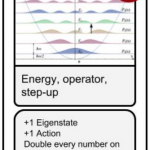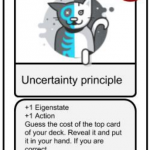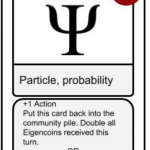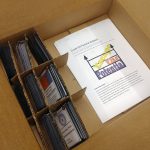Overview:
Escape the Potential is an educational game that I designed with Aidan. The main goal of this game is introduce quantum mechanics concepts to high school students with a background in physics. It could also be used as a review for college level students. While Aidan focused more on the logistical side of designing the game, I focused more on the pedagogy.
How to Play:
This game is for 2-4 players and the goal is to ‘escape’ the potential well. There are three different potential well boards you can choose to play with; infinite square well, finite square well, harmonic oscillator well (shown below).
- finite square well
- SHO well
- infinite square well
Each player starts with three cards in their hand. Players take turns playing their hand and earning eigencoins as they move up eigenstates in the potential well. Once a player has earned eigencoins, they can choose to save them or to purchase new cards (shown below).
- angular momentum
- blackbody radiation
- CERN
- entanglement
- Fabiola Gianotti
- hydrogen
- Lene Hau
- lowering operator
- Maria Goeppert-Mayer
- normalize
- photoelectric effect
- raising operator
- schrodinger’s cat
- spooky action at a distance
- tunneling
- Vera Rubin
- wavefunction
Before they can purchase the new card though, they must learn about the card using the card appendix. Over the course of the game, players purchase enough cards that they are able to escape or tunnel out of the well at the end of their turn.
The complete set of rules are here.
How to Teach:
This game is simple to implement as a teacher. The thing the teacher should focus on is answering student questions and making sure the class is engaged. I created a potential lesson plan a high school physics teacher could use in the classroom. It would be an ideal game to play at the end of the school year after students have been familiarized with classical physics concepts.
I based the pedagogy of this game and the lesson plan off of three main ideas:
- Focus should be more on interpretations of quantum mechanics than on calculations. [1]
- Emphasis should be placed on the difference between the quantum concepts students are learning and the classical concepts they are familiar with. [2]
- It should be made clear that quantum physics is probabilistic and not deterministic. [3]
By teachers putting the spotlight on interpretations of quantum physics, students will be able to grasp the concepts instead of struggling with the complicated calculations. After playing this game, I want students to have a greater appreciation for the world and a broader understanding of what physics is and how it applies to them.
My Experience:
Making this game forced me to really make sure I knew the basics of quantum mechanics. Additionally, I got to learn about a range of complicated, fascinating quantum phenomena like quantum entanglement and action at a distance. I like making lessons plans, and it was nice to see my vision for the game evolve and come together in the end. I wanted to create a fun and interactive way for high school students to get their first taste of quantum physics. After the initial struggle of coming up with what type of game we wanted to create and what we wanted students to get from it, the entire process was rewarding and fun. It was just a matter of researching, creating, playing, and revising our game.
Escape the Potential would not have been the same if it hadn’t been for Aidan. He was very detailed oriented and on top of creating the foundations for our game. I enjoyed getting to be creative and applying some of what I’ve learned in my education courses to my physics course. Overall, my experience was positive and I grew from it.
Our game is available to play in Sanders Physics 201.1.
- Not included in the picture are the “Eigencoins” used as currency in the game. They are large silver coins.
References:
All images are from Wikimedia and are available for use under the (insert link for creative commons).
[1] . C. Baily and N. D. Finkelstein, “Teaching and understanding of quantum interpretations in modern physics courses,” American Journal of Physics (January 2010). https://doi.org/10.1103/PhysRevSTPER.6.010101
[2] R. Müller and H. Wiesner, “Teaching quantum mechanics on an introductory level,” American Journal of Physics (March 2002) https://www.tu-braunschweig.de/Medien-DB/ifdn-physik/ajp.pdf
[3] K. Krijtenburg-Lewerissa, H. J. Pol, A. Brinkman, and W. R. van Joolingen, “Insights into teaching quantum mechanics in secondary and lower undergraduate education,” American Physical Society (February 2017) https://doi.org/10.1103/PhysRevPhysEducRes.13.010109

